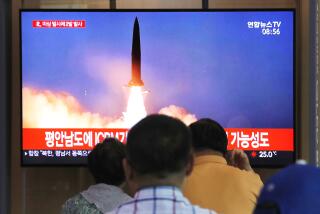20,000-40,000 U.S. Chernobyl Deaths Disputed
- Share via
A researcher’s claim that radioactive fallout from the 1986 Chernobyl nuclear accident may have caused 20,000 to 40,000 deaths in the United States is highly unlikely and based on an erroneous statistical analysis, scientists say.
The widely publicized claim was made by Jay Gould, a fellow of the Institute for Policy Studies in Washington. Gould said he had found an unexplained jump in the nation’s deaths in the months after the Chernobyl accident in the Soviet Union.
However, the amount of radiation that reached the United States is so small that the notion is “not credible,” Harvard radiation expert Edward Webster said.
“Very Low Doses”
Webster, who serves on a United Nations committee studying health effects of Chernobyl, called Gould’s hypothesis “a mechanism which most knowledgeable radiobiologists would throw out because of the very low doses involved.”
A federal health statistics official added that no mysterious increase in deaths occurred in the summer of 1986.
Gould claims that federal health statistics show an unexplained jump of 20,000 to 40,000 deaths between May and August of 1986, after the April accident. He hypothesized that radioactive fallout from Chernobyl is “the only explanation we’ve been able to develop.”
Gould, who was traveling abroad this week, had said the fallout reaching the United States encouraged formation of “free radicals,” chemically reactive molecules that can damage cells. Further, he speculated, these molecules may have sufficiently weakened the immune systems of some people to make them vulnerable to fatal diseases.
Seasonal Patterns
Gould said 33.06% of all 1986 deaths occurred in May through August, but a review of mortality data by The Times shows the true number to be 32.2%--which is identical to the data for the summer months of 1984 and consistent with normal seasonal mortality patterns. The 1985 rate was 31.6%.
The Times calculations were based on the more complete statistics contained in the annual summary reports from the National Center for Health Statistics, whereas Gould’s calculations were based on incomplete month-by-month totals.
Harry Rosenberg, chief of the center’s mortality statistics branch, agreed, saying that Gould’s mortality statistics were not “properly calculated” because they were based on a sample of death certificates that was not meant to be representative of the population as a whole.
Life Expectancy Up
Data from the center also shows that in 1986 the overall death rate, which takes age into account, was the lowest in U.S. history and that life expectancy for children born in that year reached a record high of 74.9 years.
“We didn’t see anything that departs from the historic pattern,” Rosenberg said. “His (Gould’s) numbers are not consistent with the numbers that are adjusted to represent the U.S. as a whole.”
Rosenberg added that the 1986 death rate was the lowest ever recorded, after the population’s changing age composition is taken into account.
Neal Nelson, a radiation biologist for the U.S. Environmental Protection Agency, also said he is skeptical of the Chernobyl hypothesis.
The maximum dose of Chernobyl radiation in the United States was only about 1% of the normal background exposure, he said.
More to Read
Sign up for Essential California
The most important California stories and recommendations in your inbox every morning.
You may occasionally receive promotional content from the Los Angeles Times.













